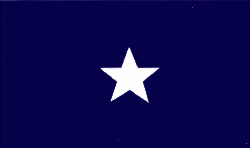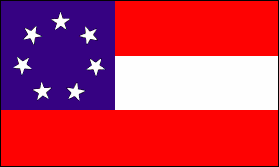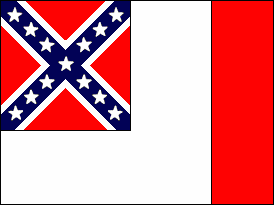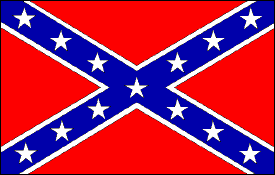Flags of the Confederate States of America
|
|
The following are the flags used by the short-lived Confederate States of America. Though they have largely ceased to be used since the end of the American Civil War, some Southern Americans continue to use the flags as a symbol of their history. The Confederate battle flag (see below) was flown (until recently) over the South Carolina State House. It now flies over a monument on the state house grounds. The design of the Confederate flags has also been incorporated into the state flags of Arkansas, Mississippi, and Georgia.
| Contents [hide] |
The Bonnie Blue Flag
Originating in Republic of West Florida in the early 1800s, the Bonnie Blue Flag was the unofficial first flag of the Confederate States of America, the South united under one star. The Republic of Mississippi used it as its official flag for a short time. This flag was also the first flag of the Republic of Texas and is also the inspiration for the Lone Star flag of Texas, and the red star in the Bear Flag of California. In 1861, an Ulster immigrant named Harry McCarthy wrote "The Bonnie Blue Flag," a popular marching song.
Modern usage, for some, is a way of representing favor for the American issue of "states rights" (subject of The Federalist Papers), without the perceived offense associated with the "Rebel Flag," below.
The First National Flag, "The Stars and Bars"
The first official flag of the Confederacy was The Stars and Bars, which was flown from March 5, 1861 to May 1863. It caused confusion on the battlefield because it was so similar to the Stars and Stripes of the Union forces.
The Second National Flag, "The Stainless Banner"
Stainlessbanner.png
image:stainlessbanner.png
The second national flag of the Confederacy was The Stainless Banner, which was put into service on May 1, 1863. To avoid battlefield confusion between the Stars and Bars with the Union's Stars and Stripes, this new flag was designed with the battle flag placed in the first quarter. This flag, however, had its own problem: when the battlefield was windless, it was sometimes mistaken for a flag of surrender because all that could be seen was the field of white.
In the South, the nickname "Stainless" was held to refer to "the unspotted virtue and honor of Southerners and their fight for independence from the tyranny and aggression of northern states." The flag is often referred to as the "'Stonewall' Jackson Flag" due to its inaugural use of covering Gen. Jackson's coffin at his funeral.
The Third National Flag
This is the third official flag, adopted March 4, 1865, very shortly before the fall of the Confederacy. The red vertical stripe was added to dispel confusion with the flag of surrender when the flag was not unfurled
The Battle Flag
The battle flag of the Confederacy is square, of various sizes for the different branches of the service: 48 inches square for the infantry, 36 inches for the artillery, and 30 inches for the cavalry. It was used in battle from November 1861 to the fall of the Confederacy. The blue color on the Southern Cross in the battle flag was navy blue, as opposed to the much lighter blue of the Naval Jack. The Stars and Bars were too easily confused in the smoke of battle with the Stars and Stripes, resulting in very real military mistakes. To remedy this, General P.G.T. Beauregard of the Army of Virginia and others sought a better design and Beauregard was the first to adopt the flag from the design of William Porcher Miles (see below). Miles' rectangular design was sized down to a square to aid folding and carrying in battle.
The flag is also known by historians as the flag of the Army of Northern Virginia.
This flag proved so popular, that it became basis for the Second National flag of the Confederacy (see above). Some prefer the square proportions of this flag over Mile's original rectangle as more sonorous and more distinct.
The Navy Jack (erroneously called the "Rebel Flag")
The Confederate Navy Jack, also called "The Southern Cross," is rectangular, usually about 5×3 feet. The blue color in the saltire (the diagonal cross) is much lighter than in the Battle Flag, and it was flown only on Confederate ships from 1863 to 1865. This flag is what is typically recognized as the Confederate flag, but this is not strictly accurate.
The design was originally made by South Carolina Congressman William Porcher Miles to be the first national flag, but it was rejected by the Confederate government for looking too much like crossed suspenders. It was used by a few army units, including the Army of Tennessee as their battle flag. Today, it is the most universally recognized symbol of the South, where it is commonly called the rebel or Dixie flag.
Sometimes, the saltire is identified as "Saint Andrew's Cross." But this is just speculation because Miles' proposals never mention this. "St. Andrew's cross" refers either to the national Flag of Scotland, a white saltire over a blue field, or the naval jack of Russia both before and after the Soviet Union, a blue saltire on a white field. St. Andrew is said to have been martyred on a diagonal cross and is a patron saint of both Russia and Scotland. A legend dating from medieval times held that the cross washed up on Scottish shores. There is no connection with legends of St. Andrew and the South. While most white Southerners at the time of the War traced their ancestry to Britain, they tended to identify their heritage as Anglo-Saxon, though it is claimed around three-fourths of all people in the South were either Scots or Scotch-Irish during the 1800s.
After the War
For some time in the Reconstruction period, public display of Confederate flags was illegal in the states occupied by Federal troops.
Controversy
What is usually called "The Confederate Flag" or "The Confederate Battle Flag" (actually the Navy Jack as explained above) is still a widely-recognized symbol. The display of the flag is controversial and a very emotional issue, generally because of disagreement over exactly what it symbolizes. To many in the US South it is simply a symbol of regional pride and heritage. Others see it as a symbol of the institution of slavery which the Confederate government defended, or of the Jim Crow laws enforcing racial segregation in the Southern States for almost a century later. According to Civil War historian and southerner Shelby Foote, the flag traditionally represented the south's resistance to northern political dominance generally; it became racially charged during the Civil Rights Movement, when protecting segregation suddenly became the focal point of that resistance.
On April 12, 2000, the South Carolina state senate passed a bill to remove the flag of the former Confederate States of America from on top of the statehouse dome by a majority vote of 36 to 7. Placed there in 1962, according to one local news report (http://www.infoplease.com/spot/confederate4.html), ‘’the new bill specified that a more traditional version of the battle flag would be flown in front of the Capitol next to a monument honoring fallen Confederate soldiers. The bill then went to the House, where it encountered some difficulty. But on May 18, 2000, after the bill was modified to ensure that the height of the flag's new pole would be 30 feet, it was passed by a majority of 66 to 43, and Governor Jim Hodges signed the bill five days later. On July 1, the flag was removed from the South Carolina statehouse.’’ Current state law prohibits the flag's removal from the statehouse grounds without additional legislation. Police were placed to guard this flag after several attempts by individuals to remove it. Ironically enough, in some people's views, the flag is easier seen now than when it was atop the State House Dome.
In 1955, the Georgia state flag was redesigned to incorporate the Confederate Battle Flag. This caused much controversy, and in January 2001, a new design was adopted intending to recognize the Confederate Battle Flag's historical significance while minimizing its prominence. Voter backlash in 2002 booted the Governor over the issue, giving way for the state's first Republican Governor in 130 years. In 2003, because of the continued controversy, the flag was redesigned yet again, without any image of the Confederate Battle Flag, although the 2003 design is an adaptation of the First National Flag of the Confederacy, known as the "Stars and Bars." In March of 2004, another vote was taken giving voters the opportunity to choose between the two most recent designs of the flag, but specifically excluded the Confederate Flag version of 1956.
The Confederate Battle Flag became a part of the Mississippi state flag in 1894, whereupon a strange series of events ensued. In 1906, the flag statutes were omitted by error from the new legal code of the state, leaving Mississippi without an official flag. The omission was not discovered until 1993, when a lawsuit filed by the NAACP regarding the flag was being reviewed by the Mississippi Supreme Court. In 2000, the Governor issued an executive order making the flag official. After continued controversy, the decision was turned over to citizens of the state, who, on April 17, 2001, voted 2-1 to keep the Confederate Battle Flag emblem on the state flag. Also at the University of Mississippi (Ole Miss) the Rebel Flag was very prevalent at the football games because the team's name, the Rebels. However, the administration banned sticks at football games in an attempt to rid the stadium of the flags, which they believed hampered them in recruiting black athletes and they also believed they were discriminatory and were bad for the public image of Ole Miss (which had already had its share of bad experiences with race relations, e.g., James Meredith). Though no longer seen in the stadium the Rebel Flag is very prevalent in the Grove, where students, fans, and alumni tailgate before the game.
The flags of Alabama and Florida still retain the distinctive saltire, while the Arkansas flag uses a design reminiscent of the Confederate Battle Flag. Aside from the controversy over official usage, many southerners - and northerners who identify with the south and its history - display the flag privately.
External links
- 1860s Harper's Weekly Images Containing Confederate Flag (http://www.sonofthesouth.net/leefoundation/Confederate_Flag.htm)
- A Brief History of the Confederate Flags (http://mshistory.k12.ms.us/features/feature2/histconflag.html) from Mississippi History Nowda:Konføderationens flag
eo:Konfederaj flagoj sv:Amerikas konfedererade staters flagga





